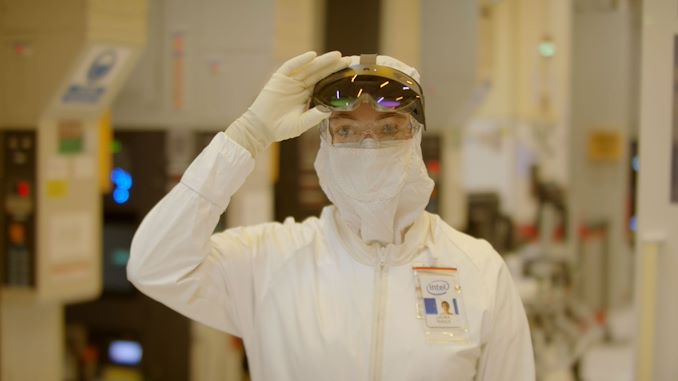Intel IFS Partners Up With Arm To Develop Improved Arm IP Designs for Intel's 18A Node
by Gavin Bonshor on April 13, 2023 1:00 PM EST
In 2016, Intel's now-defunct Custom Foundry business and Arm teamed up to bring Arm's Artisan Physical IP and POP IP for its ARM Cortex-A processor cores to Intel's 10nm process. What was meant to be a long-term deal and collaboration subsequently turned out to be anything but, as Intel closed its Custom Foundry Business in 2018 due to issues with its manufacturing. Fast forward to 2021, and Intel's CEO Pat Gelsinger laid out plans as part of its IDM 2.0 strategy and created a new Foundry Service called Intel Foundry Services (IFS).
Since the launch of Intel's Foundry Services, it has signed agreements and partnerships with several companies, including MediaTek, and the acquisition of Tower Semiconductors for $5.4 billion. Intel's latest deal involves a new collaboration with Arm which are based in Cambridge, UK, to enable Arm's IP and technologies to be optimized and built on Intel's upcoming 18A manufacturing process.
Intel Foundry Services and Arm's partnership includes a design technology co-optimization (DTCO) agreement, where Arm's current and impending SoC-based IP is optimized for power, package area, performance, and cost on Intel's 18A process node. In other words, Arm and Intel are going to be developing versions of various Arm IP blocks that have been optimized for use on Intel's 18A process.
While the announcement of the deal doesn't expressly state whether or not Arm will directly be developing the cores itself, it does open the doors for further collaborations in the future. This could include other companies using Arm's IP to create SoCs, including MediaTek and even Qualcomm, who have individual agreements with Intel Foundry Services.

Render of Intel's Fab Campus in Ohio, $100 billion worth of investment in IFS
One essential part of Intel's Foundry Services was to create a standalone business offering a combination of different packaging and process technologies available to the industry. This included sourcing sites for new manufacturing facilities, including a planned location in Germany and a $20 billion investment into two new chip factories outside Ohio in the United States as part of Intel's IDM 2.0 strategy. The latest deal with Arm to optimize its designs for manufacturing on Intel's 18A node is just one part.
Despite the failure of its previous Intel Custom Foundry, which had numerous issues with its 10 and 7 nm nodes, the latest Intel Foundry Services does offer confidence to the market through this new deal with ARM. One of the most significant benefits of Intel's recent agreement with Arm allows Intel to act as an impartial fabricator and manufacturer of chips outside of its Client Computing Group (CCG) and other arms, including its graphics (AXG) division. Not just Arm but Arm's current partners will also be able to take full advantage of Intel's open system foundry model, which includes packaging, software, and chiplets as part of the agreement.
The move, including a combination of Intel's IDM 2.0 strategy, as well as the new deal with Arm to develop and optimize its SoCs for the Intel 18 A node, not only looks to build market confidence in IFS but it's a shot across the bow of the Taiwan Semiconductor Manufacturing Company (TSMC). TSMC is currently the market leader for chip manufacturing and leading-edge process nodes for chiplets designs.
It's worth noting that allowing optimizations for Arm IP in SoCs in an area Intel has struggled explicitly with in the past will enable IFS to grow and potentially expand the business into areas such as the Internet of Things (IoT) and automotive.










7 Comments
View All Comments
SydneyBlue120d - Thursday, April 13, 2023 - link
Very interesting and smart move from Intel."Qualcomm, who have individual agreements with Intel Foundry Services" AFAIK this is not true, it was just Intel dreaming so.
Gavin Bonshor - Thursday, April 13, 2023 - link
They do have an agreement with IFS for Intel's 20ALink: - https://www.anandtech.com/show/16846/intels-first-...
Also, a quote from Cristiano Amon, CEO and President of Qualcomm
"Qualcomm is excited about the breakthrough RibbonFET and PowerVia technologies coming in Intel 20A. We’re also pleased to have another leading-edge foundry partner enabled by IFS that will help the U.S. fabless industry to bring its products to an onshore manufacturing site."
SydneyBlue120d - Thursday, April 13, 2023 - link
https://www.semianalysis.com/p/intel-grossly-exagg...Question:
Just given the recent Intel announcement where you're partnering with Intel on IFS, what sort of commitment is this on your part? Is that sort of a volume commitment at this point? I realize it's some ways out, but would it be fair to say that it's going to service the U.S. consumer?
Answer: Cristiano Amon -- President and Chief Executive Officer
Thanks for the question. Look, it's actually very simple. Qualcomm, we're probably one of the few companies that, given our scale, is able to have multi-sourcing at the leading node. We have two strategic partners today, which is TSMC and Samsung.
And we're very excited and happy about Intel deciding to become a foundry and investing in leading node technology to become a foundry. I think that's great news for the United States fabless industry. We are engaged. We are evaluating their technology.
We don't yet have a specific product plan at this point, but we're pretty excited about Intel entering the space. I think we all determined that semiconductors are important and resilient supply chain is only going to benefit our business.
Qualcomm has no product plans! They are simply discussing and evaluating the technology with Intel! If this is enough for Intel to call them a customer, how far along are discussions with the 100+ potential customers they touted. To SemiAnalysis, Qualcomm sounds like they are just another a potential customer. There isn’t any actual foundry deal in place.
What was the motivation for claiming a customer here when its clearly still in the evaluation stage?
Pretty simple, Intel gets to tout the win and keep pushing the narrative that Intel is on the comeback after stagnating for years. Intel’s 20A node looks like a real technology rather than a node with huge unproven technologies such as RibbonFET and PowerVia. The narrative shifts and Intel stock holders can be excited about the future, even if the actual business is losing market share rapidly.
ballsystemlord - Thursday, April 13, 2023 - link
Interesting.Yojimbo - Friday, April 14, 2023 - link
I don't think Intel claimed there was a volume manufacturing agreement.Semianalysis seemed to be ascribing to Intel the headlines news outlets used rather then what Intel actually said:
https://www.reuters.com/technology/intel-build-qua...
The headline is "Intel builds Qualcomm chips" but in the article says "Intel did not give details how much revenue or manufacturing volume the customer wins would bring, though Gelsinger said during an event announcing the news that the Qualcomm deal involved a "major mobile platform" and engaging in a "deep a strategic manner.""
If one watches the actual event, Gelsinger announced they were "partnering with Qualcomm using their 20A process technology." On the other hand, he said "I am thrilled to announce that we have signed AWS as our first customer to use IFS packaging solutions." There's a big difference between those two statements, "partnering with" vs. "signed as customer". "Partnering with" seems a relatively common way to spice up an evaluative or development agreement. To say Intel "grossly exaggerated" is itself a gross exaggeration. What Intel said was vague and insipid, not an exaggeration. Perhaps they knew how news sites love to offer click bait in their headlines - even when the writer of the article seems to know what was an wasn't said and makes a note of it in the body of the article. If so it's a PR trick, but where did Intel exaggerate, exactly?
SydneyBlue120d - Friday, April 14, 2023 - link
After 2 years, is there anything more concrete about this agreement?name99 - Friday, April 14, 2023 - link
That seems to suggest massive confusion inside Intel (which may or may not be the same thing as "lying").The official claim say a year ago was that
- i4 and A20 were "pathfinder nodes" and for Intel-only use.
- i3 and A18 were the Foundry nodes.
So that makes the above statement rather less than convincing -- even if QC loves A20, it's not available to them... Read more carefully and Amon says a lot less than "we have actually signed an agreement with Intel".
A second interesting point raised by the ARM announcement is why an A18 announcement, but not an i3 announcement?
Well, take a look at
https://www.hardwaretimes.com/intel-cpu-roadmap-up...
Note how now the ONLY Foundry node is A18. i3 as a foundry node appears to be dead.
(I'm not making up i3 as a foundry node. Look at the slide below from mid 2022.)
https://semiwiki.com/semiconductor-manufacturers/i...
So looks like Intel is back to business as usual – PR is trumpeting the glories of future Intel two or three years from now, even as the concrete steps required to get there are being cancelled, delayed, or modified by actual engineers on the ground...
Look, I don't enjoy constantly picking at Intel. But FFS!!!
After 14nm, then 10nm, then years on 7nm, THEN all the nonsense about 5 nodes in 5 months (or whatever the slogan is) you'd think deleting one of those upcoming nodes from their public roadmap would require some sort of public acknowledgement and explanation.
But no, let's just make the change and hope no-one notices...